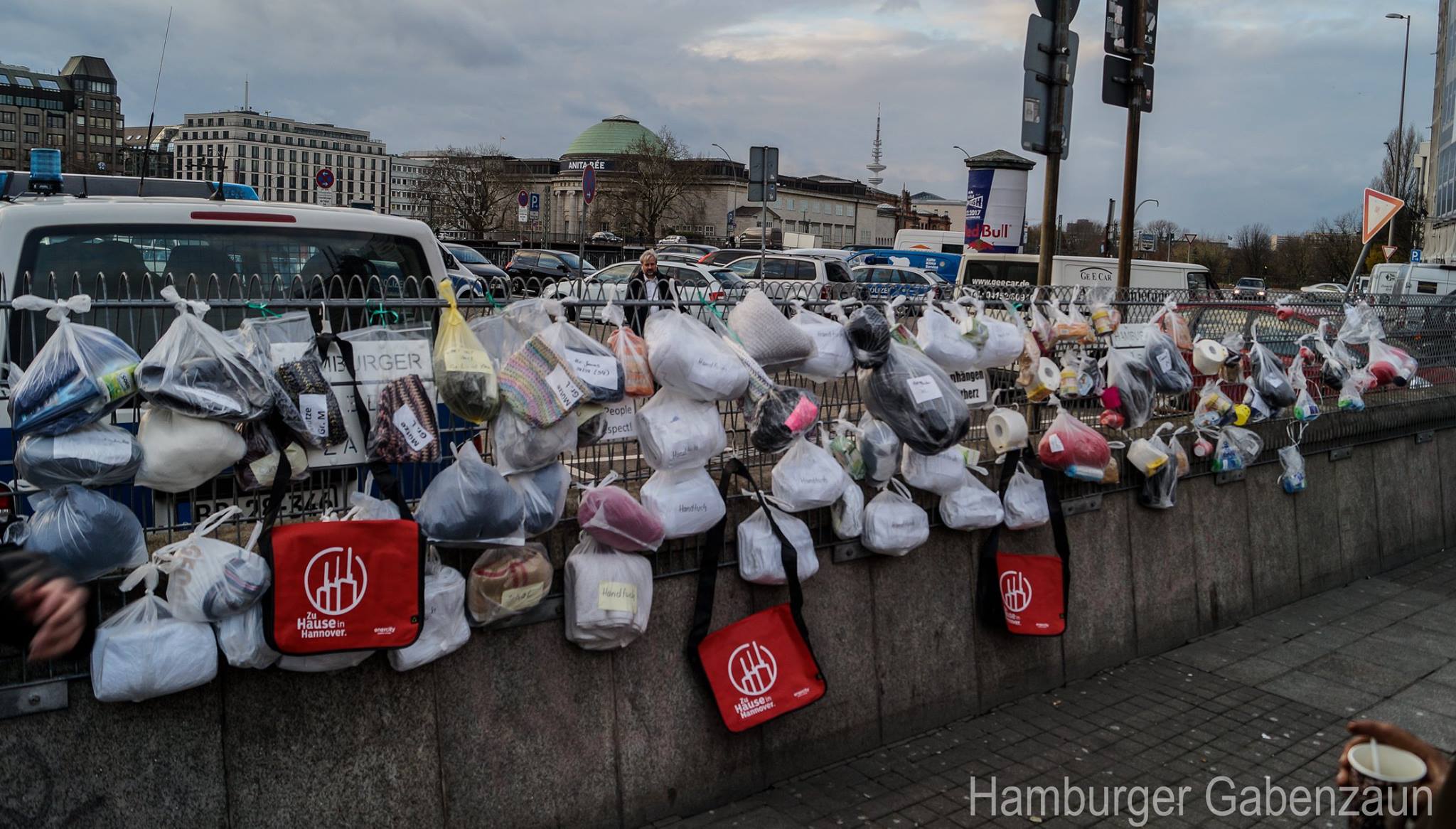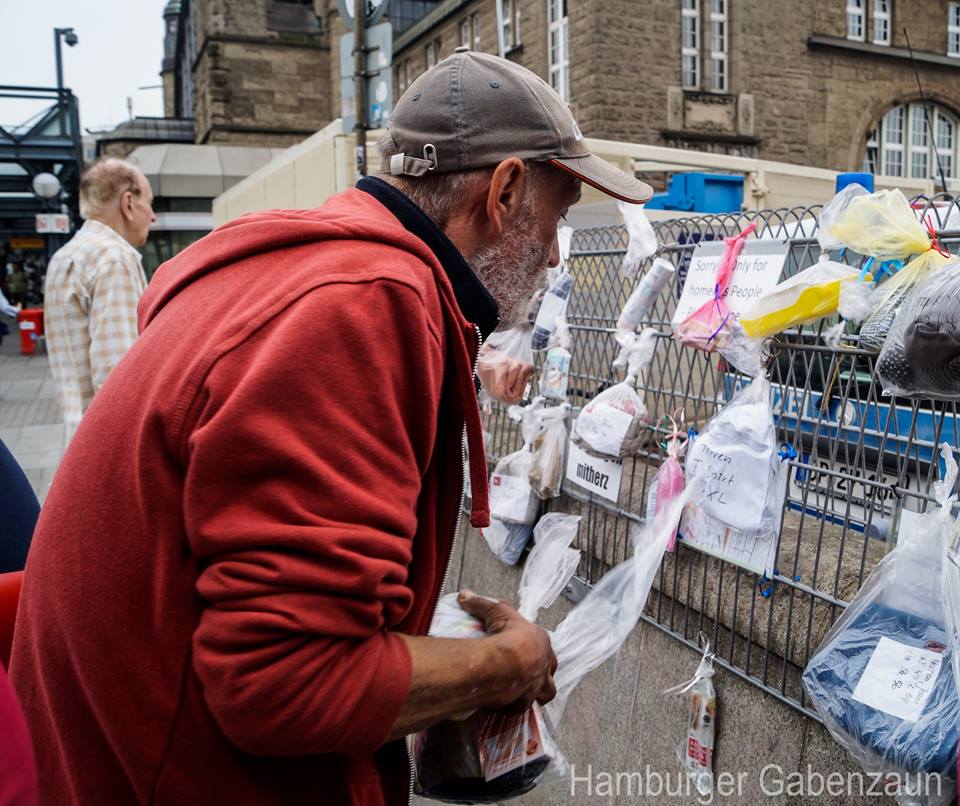Homelessness in Germany has been rising in recent years with the arrival of many refugees and growing inequalities. In Hamburg, one of the country’s wealthiest cities, about 3,000 people are homeless. One of my favourite projects in the city tries to support the homeless with a simple, but efficient approach. Read the English translation of my interview with the project’s leaders below or click here to see the original interview in German (PDF).
Hamburg’s Donation Fence (Gabenzaun) at the Central Station

Who started the project and why?
A small group of people started this project a year ago, in January 2017. All of us were active volunteers supporting the homeless even before. The project leaders are two friends.
Why did we start it? Because there is a need for an additional space where it is possible to anonymously donate and receive items regardless of opening times or week days. At the same time, the fence is supposed to be an interactive meeting point for donors and recipients to get in contact at eye level. Throwing a coin in a cup is only a fleeting moment, but talking to homeless at the Gabenzaun is something everyone remembers. It is important for us to inform and sensitise the public about homelessness and homeless people.

How does the project work logistically?
Everyone can leave their donations at the fence at any time. On our facebook page we have a guideline of items and rules. For donors who do not leave in Hamburg, we offer the service to send packages to our volunteers, who open, sort and attach the donations to the fence. Volunteers keep the donations in their living rooms or basements until it is time to transport them to the fence. Since a lot of us use public transportation, we have big blue bags and even a handcart to transport all the donations. Any donations we do not need are given to Hanseatic Help, Hamburg’s largest clothes charity. They supply various establishments with clothes donations and help us out from time to time as well. Apart from donations, we offer hot drinks, sandwiches or cake at the fence. Our volunteers prepare and transport the food.

How many volunteers do you have and which challenges are they facing?
The closer circle consists of 10 volunteers, but there is a large number of people who visit the fence on a more or less regular basis to help out. We are always in touch with them.
Challenges include learning how to establish conversations with the homeless, how to recognise their needs and to help them if needed. We can connect them to partners from other homeless associations and organisations.
It is important that any contact at the fence is voluntary. There are no conditions attached to taking donations from the fence. This often makes it easier for homeless persons to start a conversation. We are at eye-level with them and can help with many private or personal issues. As helpers, we work differently from social workers. Sometimes, a homeless person comes with a challenge like “Help, all my things got wet in the rain and I need new equipment!” We are usually able to quickly organise a sleeping bag, a camping mat, a tent, a gas cooker and other things and then meet them at the fence to hand over everything. Bigger challenges include placings in apartments. We can help to establish contacts with experts.

Do you also support homeless people on a long-term basis?
Yes. We have known many of them for a long time and support some on a more frequent basis, depending on whether they want and need us to. Every case is different and everyone needs something different. Sometimes it is only someone to listen to, sometimes it is a note of caution. We work with different organisations, which enables us to respond to countless different needs. Sometimes it is only a tentative talk with a social worker or an addiction advisor. Another important way to support the homeless is to accompany them to offices or to pay for their ID. Many of them cannot afford an ID, but without it, they cannot apply for social support or sleep in public establishments for homeless. Even for activating a SIM card, you need an ID. We receive monetary donations as well, which we use for these cases. In some cases, we have successfully found a home for our recipients.
How many bags do donors put up every day on average and which products are most popular?
This can be very different. On average, there are 40-50 bags a day, but sometimes it is a lot more. Tents, sleeping bags, gas bottles and gas cookers, camping mats, flash lights, shoes, food and seasonal clothing are very popular. Around 80% of our recipients are men, so we are currently not accepting clothes for females.

Who are the donors?
There are people from every step of society, every religion, age and gender and from all over the German-speaking countries. Some put up little bags on their way to or from work. Others clean out their wardrobe and bring big bags to the fence. Some donors send us a big parcel of lovingly wrapped donations on a monthly basis. Sometimes we experience how passers-by watch activities at the fence, engage in conversation and spontaneously donate their scarves, gloves or even jackets.

Is there a lot of interaction between donors and recipients?
Everyone can choose this for themselves. The fence offers anonymity for those who want it. But if both sides want to get in contact, they quickly get talking without any administrative or other obstacles. Some of our guests come to the fence on a very regular basis, sometimes just for the coffee, and we have become friends. We connected with a few of them via WhatsApp and they keep us informed with pictures and texts. We would say that by now, the fence has become a regular social meeting space.
Which are the challenges for the Gabenzaun?
We work here as volunteers next to our jobs and private life and spend an incredible amount of time on the fence. The founders maintain social media profiles, including twitter and Instagram, as well as the logistics of packages. There are also some challenges on the site itself. We had to move a few months ago, but now we are tolerated by the officials. They give us certain requirements to fulfil and we have make sure that it is always clean around the fence. Empty bags have to be thrown out and ripped bags need to be re-packed. Large donations need to be transported, sorted and bagged.
Often, a lot of people join us during our “fence times”. We only open once all donations are attached to the fence and we have taken pictures. We have to explain to our recipients, sometimes even in different languages, that they have to wait until this procedure is completed. Once we open the fence, we make sure that donations are distributed equally and that everyone receives something.

What are your future plans for the Gabenzaun?
We plan to start our own organisation this month. Also, we are working on some projects to further our goals, but these are still a secret. Since its foundation in January 2017, the Gabenzaun has become an institution in Hamburg. We would like to intensify our cooperation with other homeless organisations and charities.
Do the homeless have a say in urban planning? What can the fence project change?
Homeless people do not participate in urban planning at all. They are allowed to vote, but their participation is low.
Our fence project, the Gabenzaun, cannot change the level of participation of homeless in urban planning. We only offer another low-threshold space for homeless people. However, the Gabenzaun serves to increase society’s awareness for issues like homelessness and the people affected by it. Many donors have very positive experiences talking to homeless people at the fence, which helps to diminish prejudices. We have seen many surprising, thoughtful and happy interactions. On our facebook page, we share many articles about homelessness and related topics. We strive to convey impressions of the living conditions of many people and to draw more attention to citizens at the edge of society. We ask society to pay more attention and respect to the homeless, because a person is a person – with or without a roof over their head.

Thank you!
Please share your thoughts and ideas in the comment section below and don’t hesitate to contact me (laura@parcitypatory.org).
You might also like this related article:









